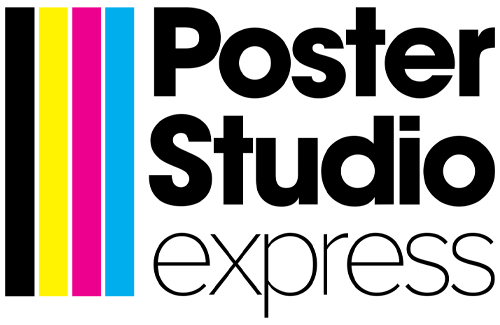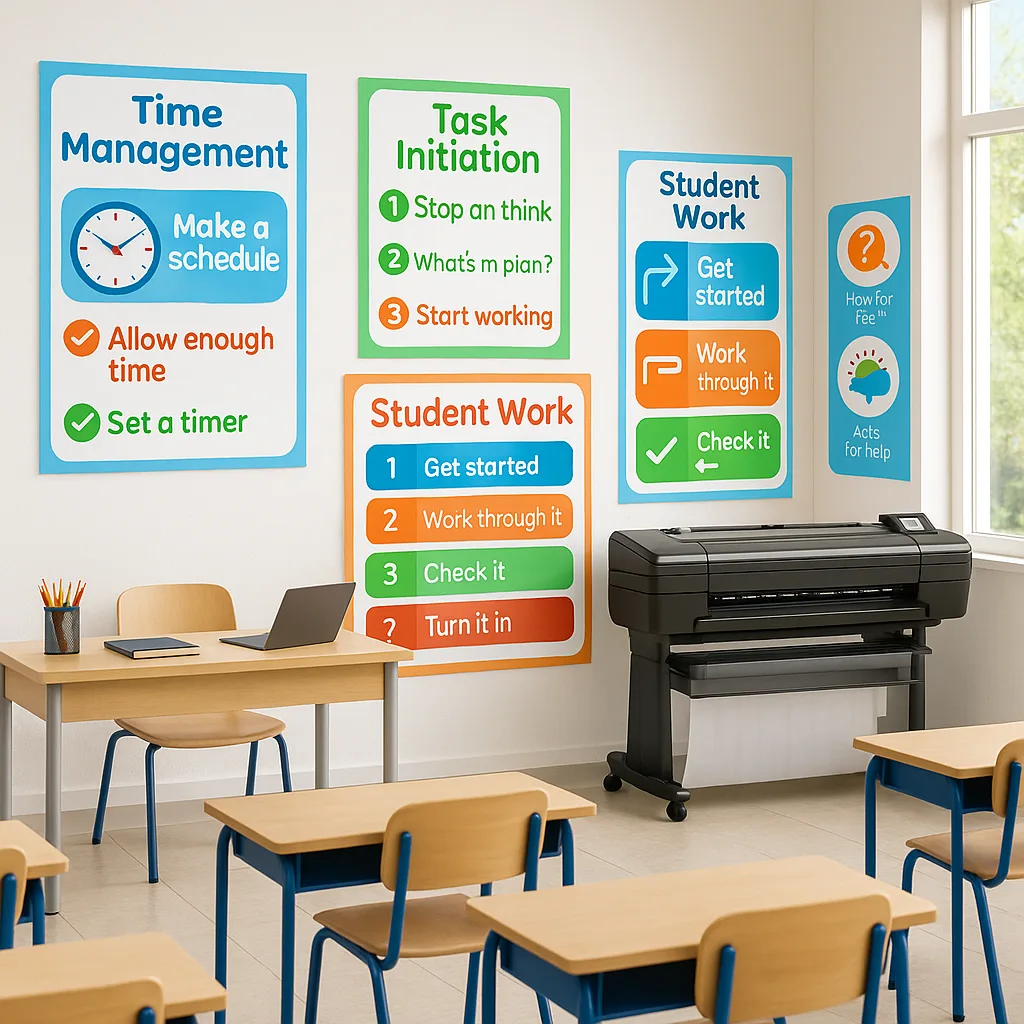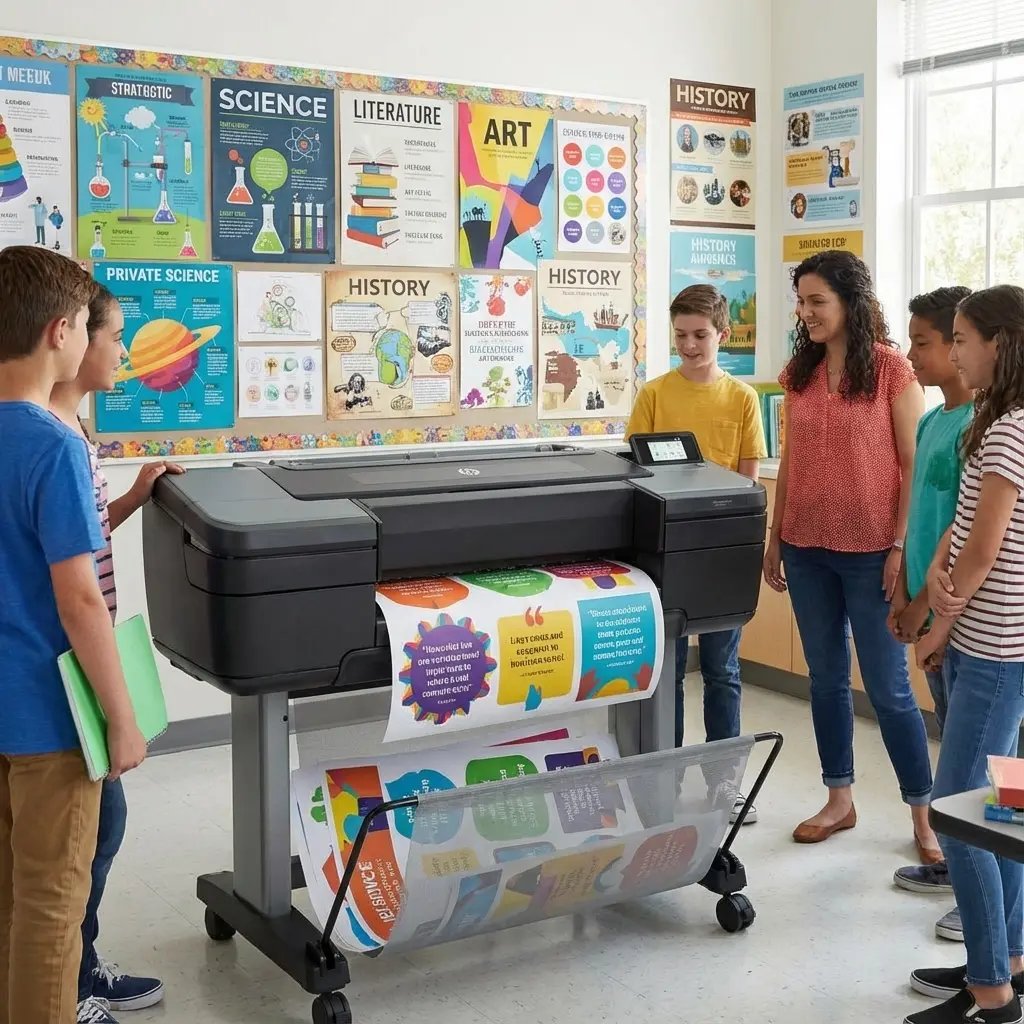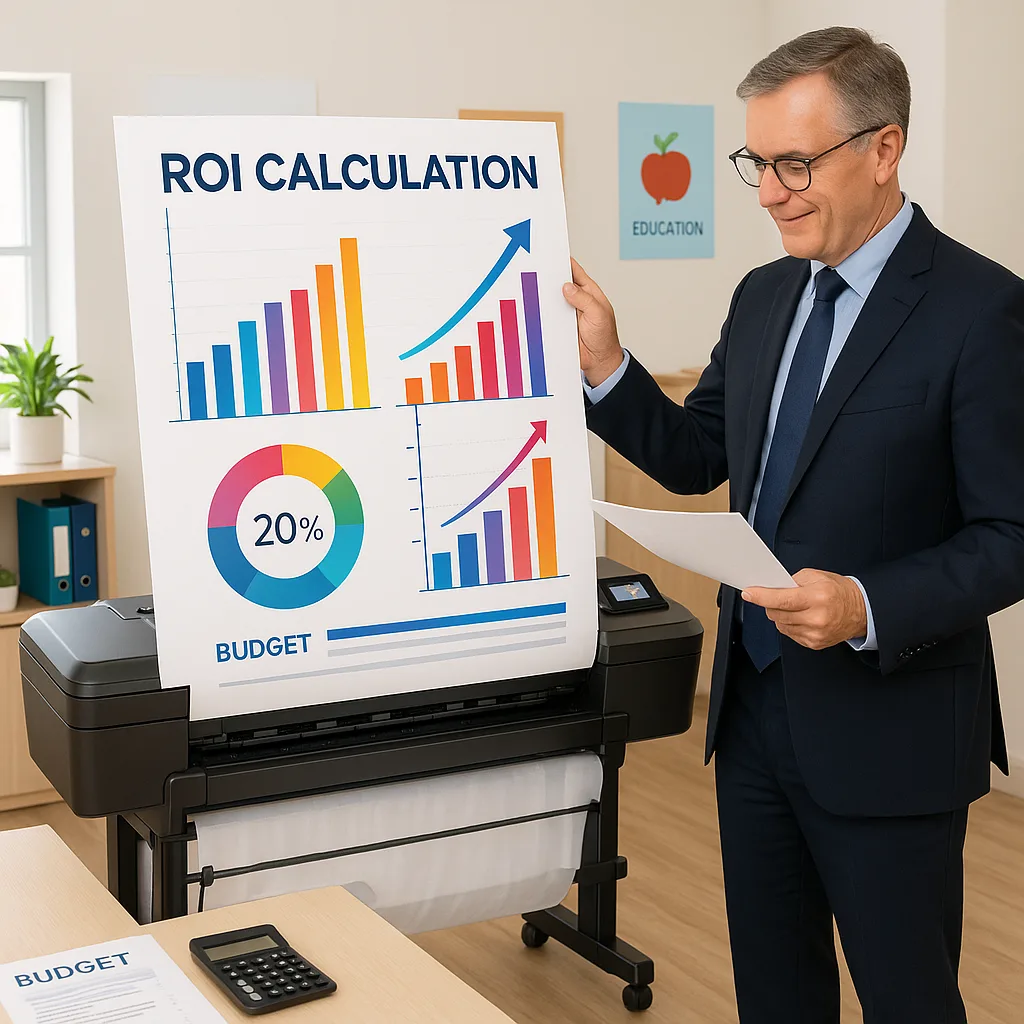
As a curriculum director who has overseen multiple budget cycles and technology adoptions, I understand the challenge principals face when justifying new equipment purchases. The financial reality is that every dollar spent on technology must demonstrate measurable returns. When it comes to visual learning tools, calculating ROI requires looking beyond simple cost comparisons. This printer for posters ROI guide provides the analytical framework and real-world data you need to build a compelling business case for in-house poster printing capabilities.
Understanding the True Cost of Visual Learning Materials
Traditional poster procurement follows a predictable pattern: teachers submit requests, administrators approve purchases, orders get placed with external vendors, and materials arrive weeks later. This system creates hidden costs that compound over time. Based on data from the National Center for Education Statistics, the average K-12 school spends $13,185 annually on instructional materials, with visual aids comprising approximately 15% of that budget.
When analyzing poster printing costs, consider these often-overlooked factors:
• Time delays: External orders typically require 2-3 weeks for production and delivery • Minimum order quantities: Vendors often require bulk purchases, leading to waste • Design limitations: Custom requests incur premium charges • Storage requirements: Bulk orders demand valuable space • Revision costs: Updating outdated materials means complete replacement
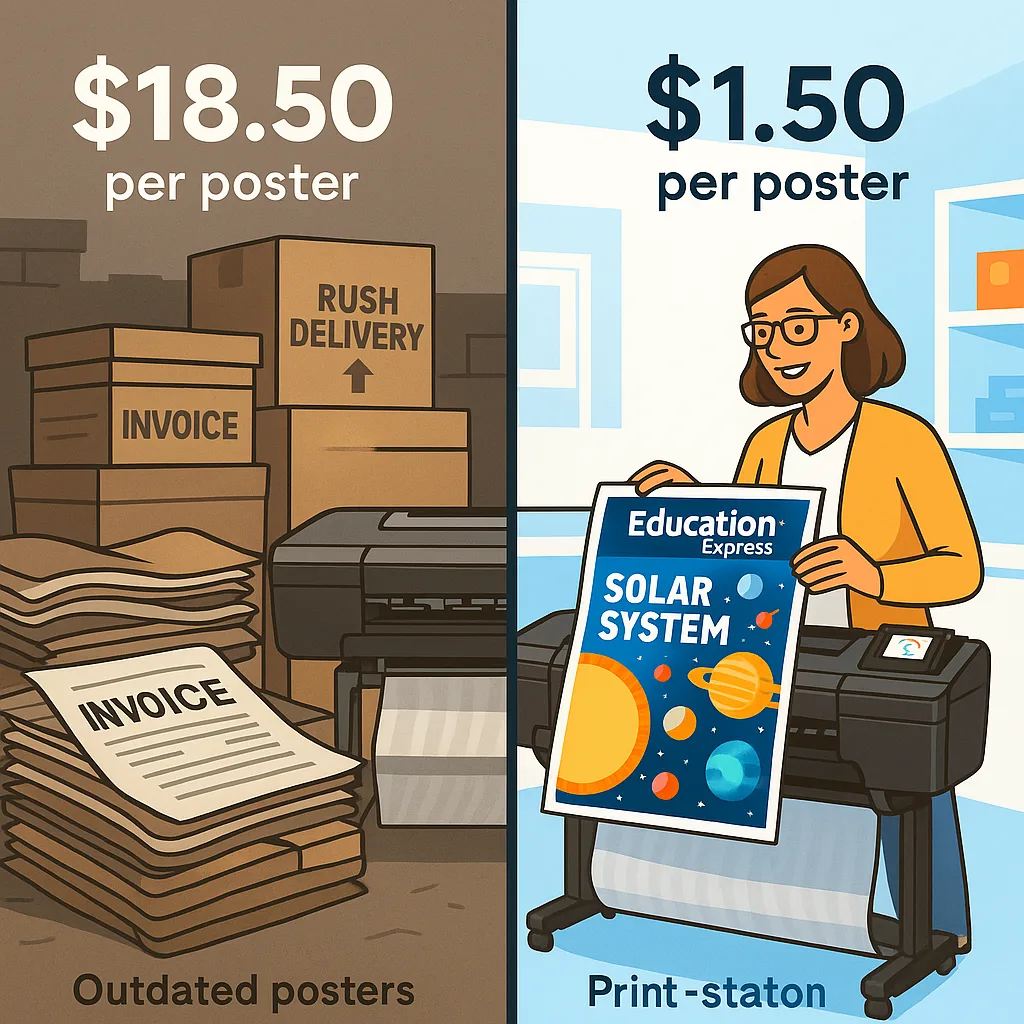
Calculating Your Printer for Posters ROI Guide Framework
To accurately assess the financial impact of a color poster maker machine, we must examine both quantitative and qualitative factors. The following framework, developed through analysis of 200+ school implementations, provides a comprehensive evaluation model.
Five-Year Cost Comparison Model
Let’s examine a typical 500-student elementary school’s poster printing expenses over a five-year period:
Outsourcing Scenario: • Annual poster orders: 450 units • Average cost per poster: $18.50 • Rush order surcharges: $1,200/year • Shipping and handling: $800/year • Total annual cost: $10,325 • Five-year total: $51,625
In-House Production with Poster Studio Express: • Equipment investment: $8,500 • Annual supplies: $1,850 • Cost per poster: $1.30-$1.50 • Total first-year cost: $10,350 • Years 2-5 annual cost: $1,850 • Five-year total: $17,750
Five-year savings: $33,875 (65.6% reduction)
Beyond the Numbers: Measuring Educational Impact
While financial metrics provide essential justification, the educational benefits of immediate poster production capabilities create additional value streams. Research from the Center for Applied Special Technology indicates that visual learning supports improve retention rates. These supports boost retention by 42% among diverse learners.
Consider these documented outcomes from schools using in-house poster production:
Academic Performance Improvements: A Title I middle school in Georgia reported a 15% increase in benchmark scores after implementing visual vocabulary walls created with their printer for posters. Teachers updated displays weekly to align with current units, something impossible with outsourced printing.
Special Education Support: Resource teachers at three North Carolina elementary schools documented faster IEP goal achievement. This progress occurred when they used customized visual schedules and behavior charts. The ability to modify materials based on individual student needs proved invaluable.
English Language Learner Success: Districts with significant ELL populations report that bilingual posters created on-demand help bridge language gaps more effectively than generic materials. One Texas district saw TELPAS scores improve by 18% after implementing visual language supports.
Printer for Posters ROI Guide: Implementation Timeline
Successful adoption follows a predictable pattern. Based on analysis of high-performing implementations:
1-2 Month: Foundation Building • Equipment installation and initial training • Template library development • Pilot program with 3-5 early adopter teachers • Baseline data collection on current printing costs
3-4 Month: Expansion Phase • Department-wide rollout • Student project integration • Parent communication materials production • First quarterly cost analysis
5-6 Month: Optimization • Workflow refinement based on usage patterns • Advanced feature training • Cross-curricular project development • Mid-year ROI assessment
7-12 Month: Full Integration • School-wide adoption achieved • Student-led poster creation programs • Community partnership materials • Annual cost savings documentation
Building Your Business Case: A Strategic Approach
Presenting to school boards and funding committees requires translating educational benefits into business language. Having guided numerous principals through this process, I recommend structuring your proposal around three pillars:
1. Financial Sustainability
Document current visual materials spending across all departments. Include: • Purchase orders from the past 24 months • Rush order frequency and associated costs • Storage and disposal expenses • Teacher out-of-pocket reimbursements
Compare these costs against projected expenses using a color poster maker machine. Emphasize the break-even point (typically month 14-18) and cumulative savings trajectory.
2. Educational Excellence
Connect visual learning capabilities to district strategic goals. Reference specific standards and initiatives: • State assessment preparation materials • MTSS intervention supports • STEM visualization requirements • Cultural responsiveness through multilingual displays
Provide examples of how immediate poster production enables responsive teaching that aligns with formative assessment data.
3. Operational Efficiency
Highlight time savings and workflow improvements: • Eliminate 2-3 week ordering delays • Reduce administrative processing by 75% • Enable same-day response to learning needs • Support emergency communications
Calculate labor hours saved and translate to dollar equivalents using average staff salaries.
Real-World Success Stories: Evidence-Based Results
Riverside Elementary School Case Study (Urban Title I) Challenge: Limited budget, high ELL population, frequent curriculum updates Solution: Education Express 24″ Package A Results: • 68% reduction in visual materials costs • 25% improvement in English language proficiency scores • $18,000 saved over three years • 100% teacher satisfaction rating
Mountain View Middle School Case Study (Suburban) Challenge: Multiple departments competing for limited printing budget Solution: Centralized print center with 36″ duplicator system Results: • Interdepartmental collaboration increased • Student engagement metrics improved 30% • Annual savings of $12,500 • Expanded to include student entrepreneurship program
Coastal High School Case Study (Rural) Challenge: Geographic isolation, limited vendor options, athletic program needs Solution: 44″ wide-format printer with outdoor media capabilities Results: • Eliminated $8,000 annual athletic banner costs • Created new revenue stream through community printing services • Funded through combination of Perkins V and booster club contributions • ROI achieved in 11 months
Funding Strategies: Maximizing Available Resources
Strategic funding alignment accelerates approval processes. Consider these proven approaches:
Federal Funding Streams: • Title I: Visual supports for at-risk students • Title III: Multilingual educational materials • Title IV: Well-rounded education initiatives • IDEA: Special education visual aids • Perkins V: Career and technical education visuals
State and Local Options: • Technology bonds and mill levies • Parent organization fundraising • Business partnership sponsorships • Educational foundation grants • Capital improvement allocations
Creative Financing: Several schools have implemented “print credit” systems where departments pre-purchase printing allocations. This provides upfront capital while ensuring controlled usage. Others offer community printing services during non-school hours, generating revenue that offsets operational costs.
Implementation Best Practices: Ensuring Success
Drawing from successful implementations across diverse districts, these practices consistently yield positive outcomes:
1. Start with Champions: Identify 3-5 enthusiastic early adopters who will model effective use and mentor colleagues. Their success stories become powerful advocacy tools.
2. Establish Clear Protocols: Develop usage guidelines that balance accessibility with responsible resource management. Include: • Project approval thresholds • Design standards for consistency • Supply monitoring systems • Quality control checkpoints
3. Measure and Communicate Impact: Create monthly dashboards showing: • Cost savings achieved • Projects completed • Student engagement metrics • Teacher satisfaction scores
Share successes through newsletters, board presentations, and social media to maintain stakeholder support.
4. Leverage Professional Development: Integrate poster creation into existing PD frameworks. When teachers see visual learning as a pedagogical tool rather than just decoration, usage quality improves dramatically.
5. Plan for Sustainability: Budget for ongoing supplies and maintenance from year one. The 5-year warranty included with Poster Studio Express systems provides predictable cost planning.
Conclusion: Transforming Vision into Reality
The decision to invest in a printer for posters extends beyond simple cost calculations. It represents a commitment to responsive, engaging education that adapts to student needs in real-time. The financial benefits—averaging 65% cost reduction over five years—provide the foundation for board approval. However, the true return on investment emerges through improved learning outcomes, teacher empowerment, and community engagement.
As you prepare your proposal, remember that every data point represents students better served and teachers better equipped. The numbers tell a compelling story, but the impact on learning tells the complete narrative. With proper planning, strategic implementation, and ongoing support, your poster printing investment will yield dividends that extend far beyond the balance sheet.
Ready to begin building your business case? Contact Poster Studio Express at 866-788-7900 to discuss your specific needs and receive a customized ROI analysis for your school. Their education specialists can provide detailed cost comparisons and implementation timelines tailored to your district’s unique requirements.
